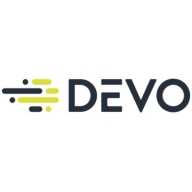

OpenText Enterprise Security Manager and Devo are key players in the Security Information and Event Management (SIEM) field. While OpenText excels in integration and compliance, Devo's strengths lie in data analytics and cloud capabilities, giving Devo the edge in flexibility and operational insights.
Features: OpenText Enterprise Security Manager supports a wide range of device protocols, robust correlation, and event aggregation for security investigations, making it highly customizable. It includes strong compliance tools and integration capabilities for diverse security needs. Devo focuses on data visualization with Activeboards, enabling comprehensive viewing of historical data for up to 400 days. Devo's advanced analytics and interactivity enhance operational insights and flexibility across varied deployments.
Room for Improvement: OpenText struggles with complex setup, slow storage infrastructure, and limited scalability, with users reporting a steep learning curve and inadequate technical support. Devo's challenges include metadata pricing and a need for stronger out-of-box content for monitoring, with both platforms requiring enhanced reporting and third-party integrations.
Ease of Deployment and Customer Service: OpenText primarily supports on-premises deployment, facing criticism for poor customer service, especially from government clients. Devo's cloud-native architecture facilitates easy scaling within hybrid and public clouds. Despite cost management issues, Devo offers more engaging customer service compared to OpenText's traditional methods.
Pricing and ROI: OpenText's pricing is viewed as expensive, relying on complex licensing structures. It offers a favorable ROI for large deployments, albeit with high initial investments. Devo provides a cost-effective, data ingestion-based pricing model fostering predictable budgeting. However, metadata pricing can occasionally diminish savings, yet it remains attractive for managing extensive data volumes efficiently.
| Product | Market Share (%) |
|---|---|
| OpenText Enterprise Security Manager | 1.6% |
| Devo | 1.1% |
| Other | 97.3% |


| Company Size | Count |
|---|---|
| Small Business | 7 |
| Midsize Enterprise | 4 |
| Large Enterprise | 11 |
| Company Size | Count |
|---|---|
| Small Business | 37 |
| Midsize Enterprise | 14 |
| Large Enterprise | 57 |
Devo is the only cloud-native logging and security analytics platform that releases the full potential of all your data to empower bold, confident action when it matters most. Only the Devo platform delivers the powerful combination of real-time visibility, high-performance analytics, scalability, multitenancy, and low TCO crucial for monitoring and securing business operations as enterprises accelerate their shift to the cloud.
OpenText Enterprise Security Manager enables real-time threat detection through scalable and adaptable solutions, integrating seamlessly with multiple platforms for complex security scenarios across different environments.
OpenText Enterprise Security Manager offers extensive security monitoring capabilities, combining log analysis and incident management to enhance cybersecurity and compliance. Its powerful event correlation engine provides real-time alerts for rapid incident response. Users benefit from customizable dashboards and comprehensive log collection, making it a significant tool in the SIEM market. Flexible deployment options cater to both on-premises and cloud environments, supporting enterprises in managing IT infrastructure and threat detection efficiently.
What are the key features of OpenText Enterprise Security Manager?In industries such as finance, healthcare, and energy, OpenText Enterprise Security Manager is implemented for monitoring critical systems and ensuring compliance with regulatory needs. Enterprises leverage its capabilities for forensic investigations and active threat management, serving as a central hub for cybersecurity operations across diverse IT infrastructures.
We monitor all Security Information and Event Management (SIEM) reviews to prevent fraudulent reviews and keep review quality high. We do not post reviews by company employees or direct competitors. We validate each review for authenticity via cross-reference with LinkedIn, and personal follow-up with the reviewer when necessary.